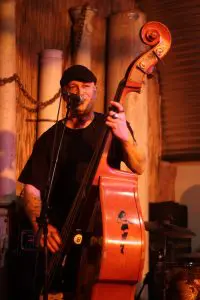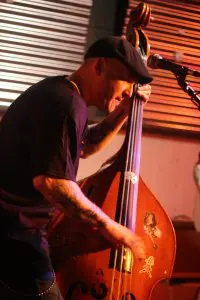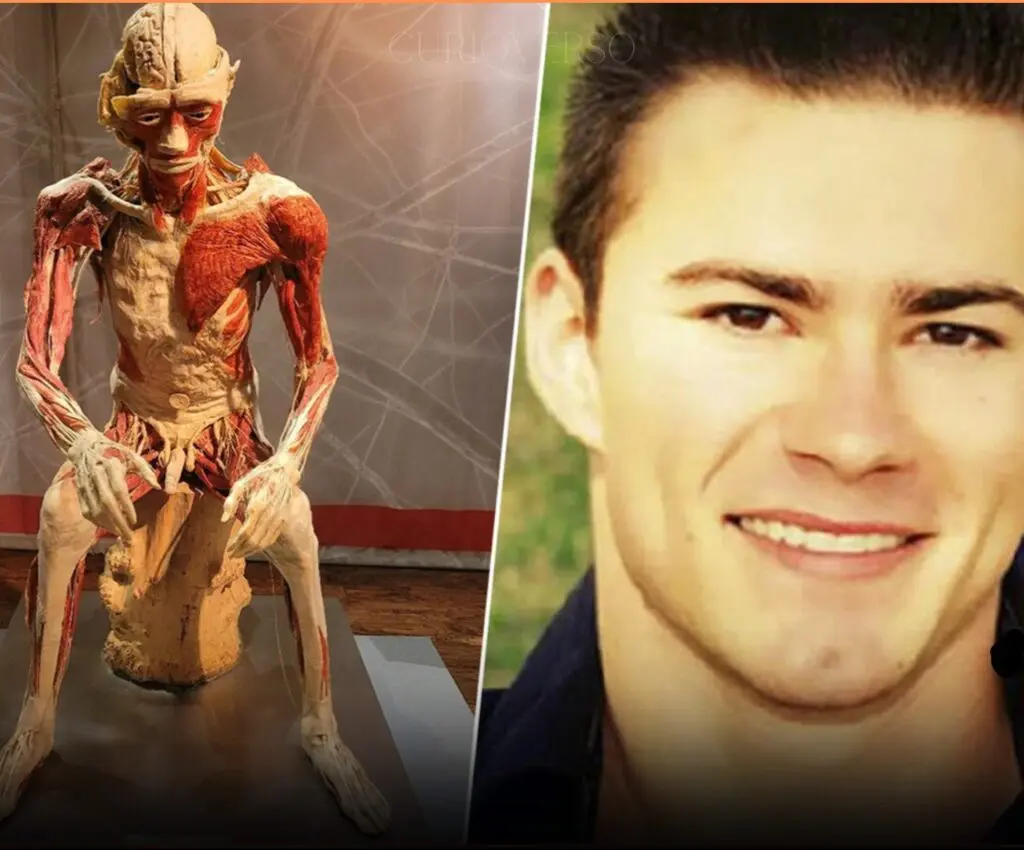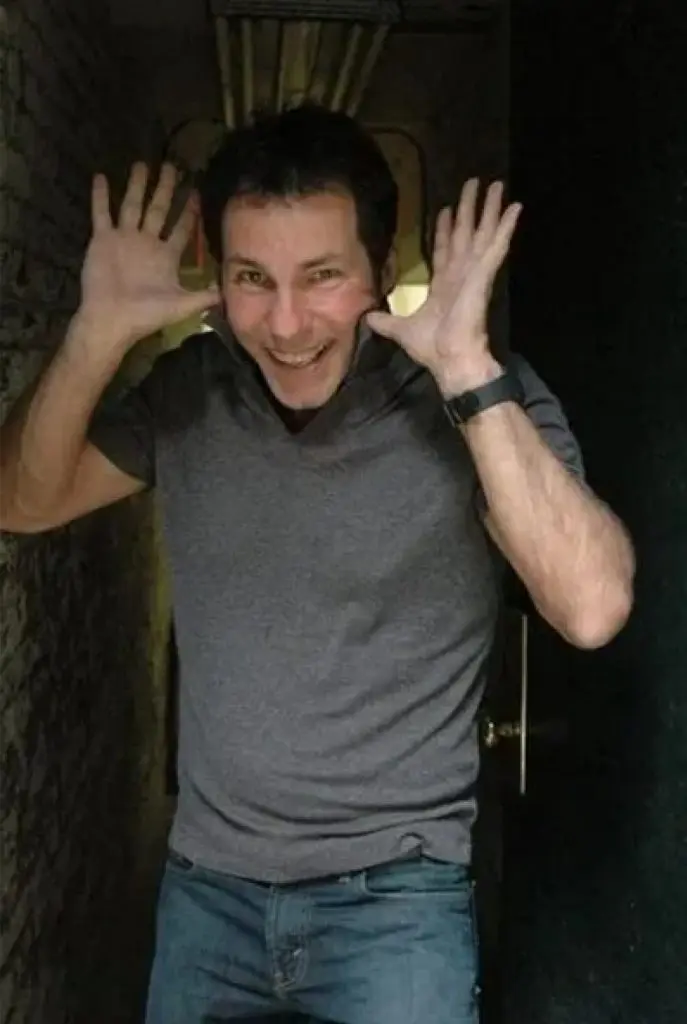Rockabilly is fun. Admit it. And imagine a guy in flash, singing about juke joints and dancing with a big, shiny stand-up bass – meet Jaybird Gorleski. Former bass player for Rocky Velvet, the Cobras and Slick Fitty, Jay Bird is a commanding stage presence.
We sit down with Jaybird and talked shop and the sock-hop.
RRX: We’ve interviewed rockabilly artists before, in particular Johnny Rabb. Rockabilly is a genre that’s perhaps more open to interpret than maybe something like jazz or classical. If you had to pick out the essence of rockabilly, what would you say it is? What makes rockabilly distinctive from rock and roll?

Jaybird Gorleski. Photo by Amy Modesti.
JBG: Well, rockabilly is a way of life. For me, it has changed my life from all the way back to when I first heard Elvis, Little Richard, Jerry Lee Lewis, and many more – every style of rockabilly. Rockabilly is distinctive from rock-and-roll because it is the beginning of the best era. 1950s music is, in my book, the best there is. I can thank John Tichy from Commander Cody for the inspiration to help me on my journey to rockabilly rock-and-roll.
RRX: You’ve been playing stand-up bass for over 30 years. Did you start out with a stand-up bass? And assuming that you have played a “regular bass” at some point, what are some of the most important differences in terms of playing that a different bass player might want to know if they were to pick it up?
JBG: Playing an electric and a stand-up is comparable to driving a car (electric) and a Mack Truck (stand-up.) They are two different animals. I started out in my sophomore year of high school playing electric bass. I basically taught myself by listening to tapes on my boombox. After high school, I joined Rocky Velvet and started listening and learning rockabilly. During this time, I bought an upright and was told, “if you’re in a rock-and-roll band, you need to play the upright.” So I learned and studied my ass off. The rest is history.
RRX: We’re in a very eclectic time, in terms of music these days. I mean this not just in mashups of genre, but also the use of what we’ll call “non-standard” instruments, which we could call a stand-up bass, at least these days. Do you think the stand-up has grown in popularity from when you first started playing it?
JBG: The stand-up bass has always been a rockabilly standard from listening to many new and old rockabilly bands; it’s the most popular instrument in the band. Such a difference between playing an electric bass, then an upright bass in any rockabilly band. And yes, it’s a little difficult at times to do a three hour show, but it is worth the sound, and playing it.
RRX: Half of our readership is probably aware that in the early history of bass, there was only the stand-up, and the other half may think that it was always a specialized piece. How well are you able to tap into the deep history of the instrument when you’re giving your all to the crowd?
JBG: All I got to say is, when I bring that bass into a gig, people go nuts and I show them that this is a real bass… not a cello. Once they hear a little slap, they are blown away.
RRX: Rockabilly is a very high energy music. There’s not only the energy of the music, but there’s the energy of the stage show. If you had to describe rockabilly to someone that was going to make a one-scene movie, what kind of a scene would you most want them to create for rockabilly?
JBG: Mmmm… Well, I would say any scene with pinups, hotrods, slick-back hair, swing dancing, a rocking rockabilly band, and tattoos. Viva Las Vegas is probably the one festival that says it all. There are many other festivals, like New England Shake Up, Nashville Boogie, Viva East, and any classic car show. Youtube can bring rockabilly to life. I did get a chance to plat Viva East two times.
RRX: I usually don’t ask about influences. But I feel like your influences might open people’s eyes to a side of music they might not have visibility on. Who are your biggest influences on a stand-up bass? Or bass in general? And in rockabilly; who have you found inspiration in watching and listening?

Rockabilly’s more than just a sound. Photo by Amy Modesti.
JBG: Definitely Kevin Smith from the band High Noon. I studied him for twenty-six years. That band is an amazing three-piece rockabilly, juke joint, swing influence. Wayne “The Train” Hancock was a huge influence as well. I got to be onstage with him in Troy at the Ale House. I must say that my man Chops La Conte from the Lustre Kings has also got me on my toes, playing as best I can to keep up with a legend of slap bass. I’m proud to know him and watch him play. One other man that inspired me was Billy Bratcher from The Starline Rhythm Boys. He is a monster on bass, and I’m proud and honored to know him.
RRX: Here’s where you answer the question I didn’t ask. What’s the proper way to spin the bass? True rockabilly attire? Educate, enlighten, emote – the floor is yours.
JBG: I personally don’t swing the bass around, but I do love to stand on it for show. The rockabilly attire is: Converse shoes, slicked back hair (which I don’t have), jeans or black slacks, chain wallet, tattoos, a nice bowling shirt or a cool rockabilly shirt. Oh… and a hot pin-up girl by your side.
You can find Jaybird Gorleski on the following Facebook pages: Upstate Rockabilly and Swing Club, Rockstar Rockabilly, and Jaybird Gorleski Fans.




 RadioRadioX
RadioRadioX